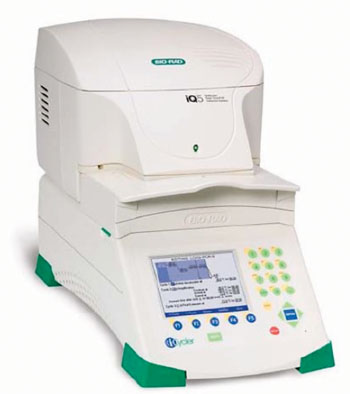Genetic Risk Factor for Premature Birth Found
By LabMedica International staff writers
Posted on 22 May 2014
A genetic risk factor for premature birth has been discovered and it is related to a gene that codes for a protein that the scientists have found helps the body’s immune cells recognize and fight group B streptococcal (GBS) bacteria.Posted on 22 May 2014
These GBS bacteria also known as Streptococcus agalactiae, are found in the vagina or lower gastrointestinal tract of approximately 15% to 20% of healthy women, but may cause life-threatening infections, such as sepsis or meningitis in newborns, especially those born prematurely.

Image: The iQ5 real-time polymerase chain reaction (PCR) detection system (Photo courtesy of Bio-Rad).
Scientists at University of California, San Diego (La Jolla, CA, USA) and their international collaborators, studied a pair of proteins that together helps balance the body’s immune response to pathogens, by directing some antimicrobial response without provoking excessive inflammation. They isolated neutrophils from whole blood from three to six different donors per genotype. Freshly isolated sterile human placentas obtained from caesarian section were used for preparation of amniotic epithelial membranes (AM).
The investigators performed gene expression analysis, cytokine secretion, and cell signaling studies. Real-time polymerase chain reaction (PCR) was performed on an iQ5 machine (Bio-Rad Laboratories; Hercules, CA, USA) and cytokines in culture supernatants were quantitated using enzyme-linked immunosorbent assay (ELISA) kits (R&D Systems; Minneapolis, MN, USA). Paraffin sections were deparaffinized, blocked for endogenous nonspecific sites, and stained with human anti-sialic acid-binding immunoglobulin-like lectin 5 (Siglec-5) and anti–Siglec-14 antibodies.
The team found that the protein Siglec-5 binds to the GBS pathogen and suppresses immune response to the microbe, while the other protein, Siglec-14, binds to the pathogen, and activates killing of the bacteria. These sialic acid-binding immunoglobulin-type lectins are cell surface receptors found typically on immune cells. They recognize and bind sialic acids, which are sugar molecules that densely coat cells. The gene for Siglec-14 is missing in some individuals, and the investigators have found that fetuses that lack the Siglec-14 protein are at higher risk of premature birth, likely due to an imbalanced immune response to the bacterial infection.
Victor Nizet, MD, professor of pediatrics and pharmacy and coauthor of the study said, “Pregnant women are universally screened for these bacteria during pregnancy and administered antibiotics intravenously during labor if they test positive to protect the infant from infection. Our study may explain why some women and their infants are at higher risk of acquiring severe GBS infections than others.” The study was published on May 5, 2014, in the Journal of Experimental Medicine.
Related Links:
University of California, San Diego
Bio-Rad Laboratories
R&D Systems














